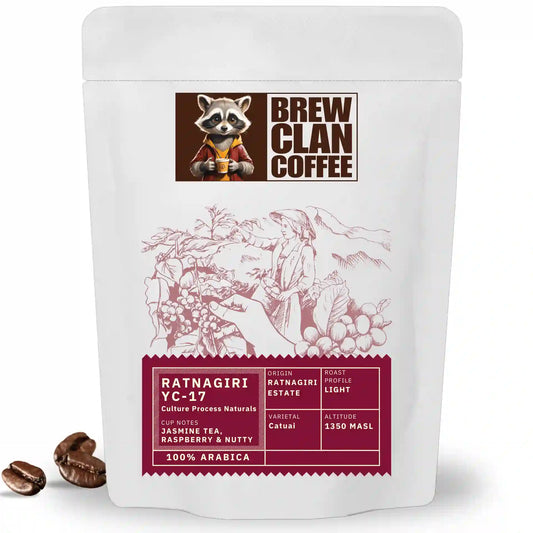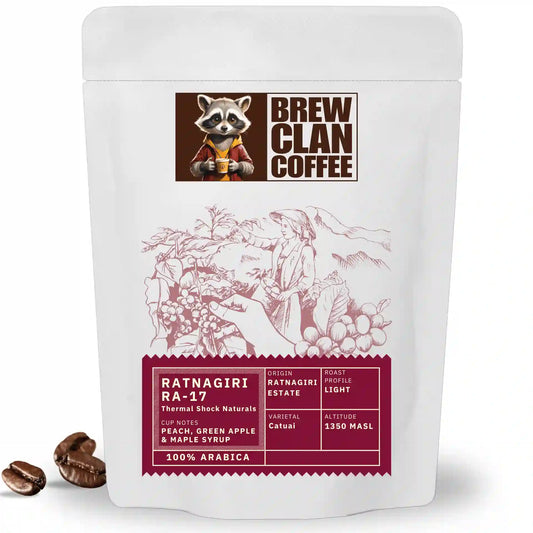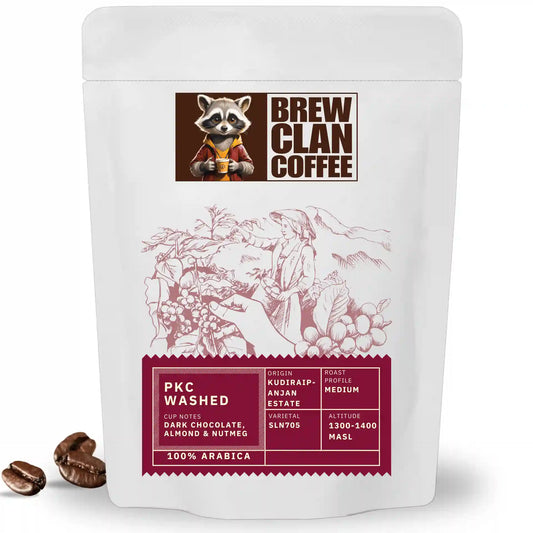
What Makes Single-Origin Indian Coffee So Special?
Share
Ever sipped a cup of coffee that just hit differently?
Not necessarily stronger - just more alive. It might have had a gentle acidity that reminded you of fruit, or a sweetness that lingered long after your last sip. That, my friend, could’ve been your first encounter with a single-origin Indian coffee, a cup that carries the personality of the land it was born in.
Because not all beans are built the same.
Some are blended for balance.
Others, like single-origin coffees are grown, processed, and roasted to showcase their individuality.
Let’s unpack what that really means.
Key Takeaways
- “Single-origin” means coffee from one farm or region - one terroir, one flavor story.
- Indian single-origin coffees are world-class, shaped by microclimates across Chikmagalur, Coorg, Baba Budangiri, and beyond.
- Traceability matters, it builds trust between grower, roaster, and drinker.
- BrewClan’s small-batch approach ensures those distinct flavors stay intact all the way to your cup.
What “Single-Origin” Really Means (and Doesn’t)
In the simplest sense, single-origin coffee comes from one specific farm, estate, or region, not a mix of beans from multiple places.

That’s it. No jargon. No marketing fluff. Just traceable coffee from a single source.
Here’s the quick comparison most people find helpful:
|
Type |
What It Means |
Taste Purpose |
|---|---|---|
|
Blend |
Mix of beans from different regions |
Consistency & balance |
|
Single-Origin |
Coffee from one estate or specific region |
Purity & expression of terroir |
So when you’re drinking, say, Ratnagiri Estate or Baarbara Estate coffee, you’re tasting the influence of that exact soil, rainfall, altitude, and even shade trees.
It’s not “better” than a blend - it’s different. Blends are like symphonies, structured, reliable, harmonious.
Single-origins are like solo performances: bold, expressive, and sometimes unpredictable.
And that unpredictability? That’s where the magic is.
Why Single-Origin Indian Coffee Deserves the Spotlight
India’s coffee scene has been quietly maturing. For decades, we were known for producing coffee that ended up in blends for international brands. But today, our estates are producing world-class single-origin coffees that can stand beside the best from Ethiopia or Colombia.
Let’s explore why.
A. India’s Diverse Terrains = Diverse Flavours
India’s coffee belt stretches from Chikmagalur and Coorg in Karnataka, through the Baba Budangiri hills, to Wayanad, Nilgiris, and all the way to the Araku Valley in Andhra Pradesh.

Each region tells a different story:
- Chikmagalur: The birthplace of Indian coffee. Think balanced cups with chocolatey, nutty undertones.
- Coorg: Known for lush forests and shade-grown coffee that often tastes earthy and mellow.
- Baba Budangiri: The holy grail of Indian Arabica - high altitude, mineral-rich soil, and beautifully complex acidity.
- Araku Valley: Tribal-grown coffee with unique fruit-forward notes and organic cultivation methods.
- Nilgiris: Clean, mild coffees with delicate florals and a silky texture.
Now zoom in further, to estates like Ratnagiri and Baarbara, where microclimates and farming practices get even more specific.
Ratnagiri’s red soil contributes to its signature wine-like acidity.
Baarbara, shaded by wild silver oaks, produces smooth, nutty coffees with a natural sweetness.
That’s terroir in action, the same concept that defines wine, now defining coffee.
B. Traceability Builds Trust
If you’ve ever looked at a bag of specialty coffee and wondered why it lists so many details: altitude, varietal, process, roast date that’s not to overwhelm you. It’s to be transparent.

Traceability simply means you can follow your coffee’s journey from the farm to your cup.
You know exactly:
- Which estate it came from,
- Which varietal of Arabica was grown,
- How it was processed (washed, honey, natural),
- And when it was roasted.
That transparency is what builds trust. It’s proof that someone, farmer and roaster alike, cared enough to let you trace its story.
And that’s what BrewClan stands for too. We don’t buy coffee off a shelf; we build relationships with estates that are as obsessed with quality as we are.
C. Specialty-Focused Estates and Craft Roasters
Estates like Ratnagiri, Baarbara, and Balanoor are pushing Indian coffee into a new era micro-lots, experimental fermentations, eco-conscious processing, and traceable lot numbers.

They don’t grow coffee for the masses; they nurture each lot for flavour.
And then come roasters like BrewClan Coffee Roasters, whose job is to respect that origin.
We roast in small batches, never in bulk, because every roast curve is tuned to that bean’s natural potential.
That’s how we make sure what you taste is authentically from the estate — not flattened or masked by over-roasting.
Flavour: Why Single-Origin Tastes “Different”

Here’s where it gets delicious.
Single-origin coffees usually feel more transparent in flavor. You can pick out notes, layers, and transitions that blended coffees might smooth over.
- Ratnagiri Estate: Jasmine tea, raspberry, and a hint of nuttiness.
- Baarbara Estate: Chocolate fudge, roasted almonds, and caramel sweetness.
- Balanoor Estate: Earthy, full-bodied, with subtle citrus.
Blends, on the other hand, are like comfort food: reliable and familiar. But single-origin cups are like exploration, each sip reveals something new about that land, that harvest, that roast.
When you start recognizing these differences, coffee stops being “just coffee.”
It becomes a conversation with the place it came from.
How to Brew Single-Origin Coffees for Maximum Flavour
If you’ve just discovered single-origin coffees, here’s how to make them shine.
These beans thrive when brewed gently, methods that let water pull flavors slowly and cleanly.
Best brew methods:
- Pour-over: highlights clarity and aroma.
- AeroPress: accentuates body and sweetness.
- French Press: great for deeper, rounder cups.
Quick tips:
- Always use freshly roasted beans — within 3–4 weeks of roast.
- Grind fresh before brewing. Medium for pour-over, coarse for French press.
- Stick to a brew ratio of 1:15–1:17 (1g coffee : 15–17g water).
- Use filtered water — it’s 98% of your coffee, after all.
👉 Remember: when brewing single-origin, your goal isn’t perfection, it’s discovery.
Why BrewClan Champions Single-Origin Coffee
At BrewClan, we’re unapologetically obsessed with origins.
We work directly with estates like Ratnagiri, Baarbara, and others that share our belief that coffee should speak for itself.
Our roasting approach is about revealing, not masking, the bean’s natural character.
We roast fresh, in small batches, because we want you to taste that terroir exactly how nature intended.
No compromises. No shortcuts.
Curious to experience it yourself?
Explore our [Ratnagiri Estate Single-Origin Coffee] — roasted to order for clarity, sweetness, and balance.
💬 FAQs
1️⃣ What is single-origin coffee?
Coffee sourced from one specific region or estate, offering unique flavor characteristics shaped by that land’s climate and soil.
2️⃣ Is single-origin better than blended coffee?
Not necessarily better, just more distinct. Blends aim for consistency; single-origins celebrate individuality and terroir.
3️⃣ Why are Indian single-origin coffees special?
India’s estates like Ratnagiri and Baarbara grow Arabica under shade at high altitudes, producing vibrant, clean, and complex flavor notes.
4️⃣ How should I brew single-origin coffee?
Try pour-over or French press to highlight clarity and subtle flavors. Fresh roast, proper grind size, and correct ratios make all the difference.
5️⃣ Does BrewClan offer single-origin coffees?
Absolutely. We roast Ratnagiri and Baarbara Estate coffees fresh to order so you taste their unique character, not just caffeine.




